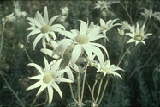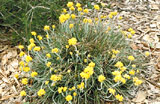|
[Front Page] [Features] [Departments] [SGAP Home Page] [Subscribe]

Grey and Silver Plants in the Australian Garden
Doris Gunn
This article is not about individual grey and silver plants in the Australian scene but rather I have researched grey and silver plants in general. I am talking about grey and silver plants from Australia, grey gardening overseas, the biology of grey plants and the various uses of grey and silver foliage in our gardens. The idea is not to dwell on individual names but to try to inspire you to do something different and grow an all grey garden or a small area within your garden or even add a few well chosen grey plants as an accent and contrast in your present garden.
Australia is a major contributor to the grey and silver scene as we have the conditions which produce grey foliage. In fact, the Australian flora is thought of as being more grey/blue than green. Actually, grey salt bush occupies some 5% of this continent. Drought prone regions such as deserts, shorelines, alpine herb fields and rocky, exposed limestone cliffs are the natural home of grey plants.
Among the first plants collected in Australia by Europeans was Conostylis candicans (Grey Cottonheads) and this was found in Shark Bay WA by William Dampier, the privateer, in 1699. This is a beautiful plant both for its form and colour and probably stood out amongst the surrounding vegetation. During Cook's voyage in 1768/70, among the first plants collected in Botany Bay were Chrysocephalum apiculatum and Actinotus helianthi. These plants no doubt caught the keen eyes of the botanists Banks and Solander sailing with Cook. There was certainly little time wasted by the English horticulturists in exploring the booty of grey plants to be found in Australia.
|
| "During Cook's voyage in 1768/70, among the first plants collected in Botany Bay were Chrysocephalum apiculatum and Actinotus helianthi" |
|
In Britain and Europe grey gardens are very popular. Botanical gardens at Kew and Edinburgh have area that are devoted to grey plants. In England there is a nursery that sells only grey and silver plants and they issue a catalogue which lists more than three hundred plants and is printed on grey paper. It was largely the White Garden at Sissinghurst in England that popularised this grey and silver cult and this garden is said by some to be the most beautiful in the world. The Nicholsons who created the gardens called the White Garden the Moon Garden for reasons which I will discuss later.
Melbourne Botanic Garden has extended the rock gardens in which grey plants are grown. Many local authorities are now planting grey plants in roundabouts, traffic islands and in landscaped gardens around buildings.

The flannel flower, Actinotus helianthi, grows on sand or sandstone on the coast and mountains of New South Wales and southern Queensland. Select the thumbnail image or highlighted phrase for a higher resolution image (24k).
Australia has many advantages in growing pale foliage, not least of which is the luxury of long, hot, sunny days throughout most of the year. It is one of the criticisms of grey gardens in Britain that they look so 'tatty' in winter when the plants are usually just twiggy tufts of cut back foliage. How dull grey plants look on wet cold days and how they shimmer in bright sunlight.
The Mediterranean coast which has a climate resembling much of Australia's climate produces a great number of the grey and silver plants which are grown in Europe. Why do the regions with hot, dry and hard climates produce such wonderful grey plants?
Grey and silver coloration is generally the result of a layer of white hairs on the leaf surface which reduces water loss by reflecting the sun's rays and which hold the moisture close to the leaf surface and thus keeps the tissues cool.
Many salt marsh plants suffer from what is known as physiological drought as they must resist the tendency to lose water to the surrounding medium which is generally a concentrated salt solution. These plants are also sometimes succulent and frequently have bluish, waxy or felted leaves such as Sarcocornia quinqueflora (Beaded Glasswort) which is highly succulent, quite leafless and often covered with a waxy bloom to minimise water loss. It is common around our coast and colonises with Disphyma blackii (Pig-face). The remarkable Avicennia marina (White Mangrove) has lustrous upper surfaces but white, felted undersurfaces to its leathery leaves.
This xerophytic way of life is manifested in a range of structural peculiarities such as small, compact fine leaves as in conifers, allocasuarinas and leucophyta in which there is a lower ratio of surface to volume. It has been noticed that if the same species of plant has forms occurring in dry and moist areas it is almost always the one in the dry area which has the denser covering of hairs. This is another reason for selecting plants from similar conditions to your own.

Conostylis candicans is a close relative of the kangaroo paws and was one of the first Australian plants to be collected by European explorers. Select the thumbnail image or highlighted phrase for a higher resolution image (47k).
Other xerophytes may have narrow leaves which are oriented with the edge towards the sun such as eucalypts. This habit helps reduce heating and therefore water loss. Leaves may also be rolled in upon themselves such as in grasses in deserts or coastal areas. The outer waxy or glaucous layer, which gives many plants a grey or bluish colour, no doubt has a water retaining function. This bloom or mealiness is easily rubbed off - one can think of many eucalypts with this property. Many plants from dry, sandy areas have a tight, compact habit which produces a humid climate within itself such as Leucophyta brownii (Cushion Bush) which resembles a ball of crumpled silver wire. There is no doubt that the hairy covering of the silver and grey plants serves to reflect light and keeps a humid layer close to the surface of the leaf, thus keeping the plant cool and reducing water loss. The reason that silver plants shimmer in the sunlight is that the hairs on these plants lie sleekly close in the sunshine but in cold, wet weather they are upright to increase water loss. Atriplex sp. (Salt bushes) have this characteristic.
There are other qualities of grey plants of which we could take advantage apart from the artistic ones. Two in particular are their qualities as fire retarders and as light reflector at night. Saltbush plants in the family of Chenopodianceae have a high salt content in their tissues and this is the reason why they have a fire suppressing capacity. Several of the ornamental greys can be used for this purpose. Atriplex sp and Rhagodia sp, the true saltbushes, make particularly fine fire breaks. Light reflecting leaf surfaces that make greys and silvers shine during the day can also be used for food effect at night. It is noticeable the grey plants are increasingly being used on traffic roundabouts and at other potentially dangerous sites: perhaps for their hardiness but also because they show up at night in car headlights. A driveway edged with Leucophyta brownii would be most effective both by day and night.
The pale foliage of blue and silver eucalypts look stunning in sunlight, but also is very noticeable in car headlights at night. Clever use of pale foliage plants in areas of your garden which can be artificially lit at night, particularly when combined with white flowers, is very striking indeed. Pale foliage and white flowers also stand out in moonlight and this is why such gardens are described as Moon Gardens.
Do not overlook the fact that grey plants are very drought tolerant are useful for those dry corners. Such plants are best grown in sunny exposed conditions but a few such as Atriplex cinerea grow quite well in shade, less compact but a good colour.
|
| "Do not overlook the fact that grey plants are very drought tolerant are useful for those dry corners" |
|
Among the grey plants now fairly commonly used overseas are Eucalyptus perriniana, E.crenulata, E.tetragona, E.gunnii, E.cinerea and E.globulus. Heavy coppicing of these trees is practised to preserve the juvenile foliage which is pale and silvery. This can be done several times and perhaps we could do more of this in our gardens.
A special area in your garden devoted to grey and silver colour and of varying leaf sizes, possibly mixed with white, blue and some pink flowers and illuminated at night would look stunning.
As I have already said, Australia is a major contributor to the grey scene and I am sure that there are still many beautiful plants that could be grown for their foliage alone that are untried, unsung and untested in the garden. These could be winners overseas and perhaps there is an opening here for growers and nurseries to specialise in and popularise grey and silver plants.
I hope I have inspired you to grow a grey garden and experiment with a few lesser known foliage plants.
This article is a reproduction of a paper presented by Doris at the SGAP 18th Biennial Seminar held at Ballarat, Victoria from 23 to 29 September 1995.
Doris Gunn has been a long-time member of the Victorian Region of SGAP and has served as President , Secretary and Newsletter Editor for the Geelong District group. She has also served as Regional Vice-president for 5 years. She has grown and propagated Australian plants for many years and now has a particular interest in the indigenous southern coastal plants of Victoria.
 [Front Page] [Features] [Departments] [SGAP Home Page] [Subscribe]
[Front Page] [Features] [Departments] [SGAP Home Page] [Subscribe]
Australian Plants online - June 1997
The Society for Growing Australian Plants
|